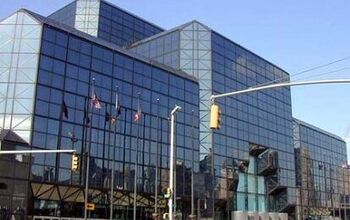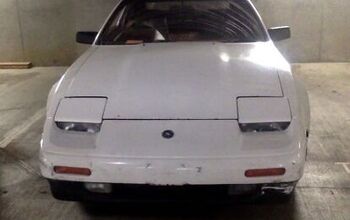The LA Auto Show Must Go On. Mustn't It?
Auto shows are intended to be recipes for excess. Take one excessively large convention hall, fill it to capacity with excessive quantities of costly chrome and metal, mix in a few brigades of excessively attractive women, and cap it off with a cadre of excessively awkward journalists (present company excepted, er, we hope) to glorify the results with excessively vapid superlatives. But that was before Carmeggedon and the Great Credit Crunch of ’08 came to town, raining on the parade with an excessively nasty vengeance. Cars are a serious business, and 2008 is looking to be about as serious as it gets.
This year’s extravaganza is most noteworthy for what isn’t happening. For starters, General Motors is a non-starter. GM has canceled both of its planned new vehicle debuts. Neither the new Buick Lacrosse nor the Cadillac CTS Coupe made the trip. Car Czar Bob Lutz, who was previously scheduled to make an appearance, is also staying home. Maximum Bob isn’t having lunch at the RenCen by himself; every other spokesperson within the GM public relations squadron, i.e. anyone who might have been required to field skeptical questions from a editorially-liberated pack of hacks, is likewise giving this show a wide berth.
Not to be outdone by its erstwhile merger partner, the Cerberus-Chrysler team was apparently too preoccupied by the Mervyns bankruptcy liquidation to dispatch anyone here, either. Aside from a few electric concepts, Chrysler has no product launches and provided no PR staff to manage and dazzle the press corps. It gets worse – according to the Los Angeles Times, the Three Headed Dog is offloading much of the cost of this year’s fete onto its Southern California dealers. The Auburn Hill Boyz have been establishing a now-familiar pattern of cramming down their problems onto their retail network, and the LA show is proving to be no exception.
Renault-NIssan head Carlos Ghosn established the weary-although-optimistic tone in his keynote speech, which opened the event. Ghosn is probably the closest thing to a rock star that you’ll find in the auto industry, and his talents for salesmanship and managing a room are top notch. Le Cost Killer fired on all cylinders, masterfully packaging the greenbacks-for-green-tech message that has been offered far less convincingly by Detroit’s troika of CEO’s.
Few seemed to notice the irony of Ghosn touting his vision of an emissions-free future on the very same day that Nissan was launching its 370Z sports coupe and Infiniti revealed its convertible, abundantly-pistoned G37.
Other subtle signs of the industry implosion are evident throughout the floor. A deathly quiet hovers across GM’s vast acreage, which occupies what should be a high-traffic area in the middle of the Convention Center’s South Hall. Much of the obligatory well-dressed eye candy seems to have been given the day off. Most painful for a hungry, coffee-powered observer such as yours truly, the customary sponsored sit-down luncheon was quietly nixed, replaced by a haphazard buffet of small stale sandwiches that made Quizno’s seem like Spago in comparison.
In keeping with the theme of tough times, many an automaker press conference made at least a passing mention of the stumbling economy, even as they proudly touted their new models. Despite the pall, everyone claims to be confident that the current tumble in auto sales is a manageable bump in the road.
The Dearborn side of the hall was considerably more cheerful. Undaunted by bailouts, the brink of bankruptcy and Congressional hearings, FoMoCo debuted the new Fusion and its badge engineered Mercury Milan sedan twin, as well as the Mustang pony car and Lincoln MKZ sedan. During their upbeat presentation of the new Fusion, Ford EVP Mark Fields and Marketing VP Jim Farley seemed not to notice the faltering car market. Crisis? What crisis?
This year’s show includes new world debuts from Bentley (Azure T Convertible), Infiniti (a convertible version of the G37), Lexus (RX 350 and RX 450h Hybrid), a brace of Porsches (Boxster and Cayman) and Nissans (370Z and Cube), as well as the new Mazda 3, an electric Mini and a VW (the TDi version of the Touareg.). Four concept cars make their premiere show appearances here: a Honda FC Sport fuel cell sport concept, Hyundai Sonata Hybrid, a Kia Borrego fuel cell vehicle, and a Toyota CNG Camry Hybrid. Tomorrow’s events will include the presentation of the Green Car of the Year award, which promises to be less controversial than last year’s Tahoe Hybrid.
Not that this will matter much. Anyone who is paying attention knows that the country’s most important auto show is not being held in Los Angeles or Detroit or Chicago or New York, but in Washington, under the DC big top, where big bailout bucks are the order of the day. It can’t help but make one wonder whether next year’s show will be considerably smaller than this one.
More by Adrian Imonti
Latest Car Reviews
Read moreLatest Product Reviews
Read moreRecent Comments
- MaintenanceCosts Nobody here seems to acknowledge that there are multiple use cases for cars.Some people spend all their time driving all over the country and need every mile and minute of time savings. ICE cars are better for them right now.Some people only drive locally and fly when they travel. For them, there's probably a range number that works, and they don't really need more. For the uses for which we use our EV, that would be around 150 miles. The other thing about a low range requirement is it can make 120V charging viable. If you don't drive more than an average of about 40 miles/day, you can probably get enough electrons through a wall outlet. We spent over two years charging our Bolt only through 120V, while our house was getting rebuilt, and never had an issue.Those are extremes. There are all sorts of use cases in between, which probably represent the majority of drivers. For some users, what's needed is more range. But I think for most users, what's needed is better charging. Retrofit apartment garages like Tim's with 240V outlets at every spot. Install more L3 chargers in supermarket parking lots and alongside gas stations. Make chargers that work like Tesla Superchargers as ubiquitous as gas stations, and EV charging will not be an issue for most users.
- MaintenanceCosts I don't have an opinion on whether any one plant unionizing is the right answer, but the employees sure need to have the right to organize. Unions or the credible threat of unionization are the only thing, history has proven, that can keep employers honest. Without it, we've seen over and over, the employers have complete power over the workers and feel free to exploit the workers however they see fit. (And don't tell me "oh, the workers can just leave" - in an oligopolistic industry, working conditions quickly converge, and there's not another employer right around the corner.)
- Kjhkjlhkjhkljh kljhjkhjklhkjh [h3]Wake me up when it is a 1989 635Csi with a M88/3[/h3]
- BrandX "I can charge using the 240V outlets, sure, but it’s slow."No it's not. That's what all home chargers use - 240V.
- Jalop1991 does the odometer represent itself in an analog fashion? Will the numbers roll slowly and stop wherever, or do they just blink to the next number like any old boring modern car?































Comments
Join the conversation
Don't forget the bitchin' "Jeep waterfall" display! That thing was probably worth the $7B that Chrysler is asking for..........
No offense, Stu, but I think the bailout business is driving so much media coverage it would have overwhelmed even the best auto show. Besides, I thought people were realizing how little these things mean now that people can see them all on the internet. It's not the same as seeing it live, but it's a lot cheaper.